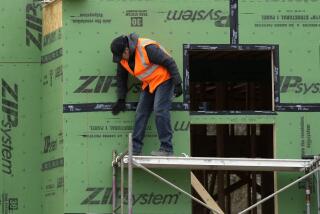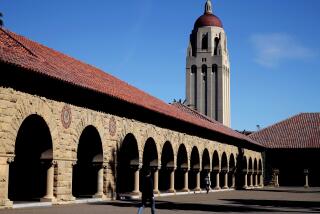Job growth in California soars

California added 150,000 more jobs last year than previously believed, signaling that economic growth in the state far outpaced the rest of the nation.
The new numbers, released Friday by the state, show California added a total of 471,200 jobs in 2014 — more than 47% higher than the previous estimate of 320,300 new jobs. The revisions boosted California’s rate of job growth to 3.1% last year, much faster than the rate of 2.3% for the nation.
“It’s incredible — it’s so many more jobs,” said Mark Vitner, a managing director and senior economist at Wells Fargo who tracks regional economic trends. “We knew there would be an upward revision, but this is just a phenomenal increase.”
Data released Friday also showed that California employers added 67,300 jobs in January, one of the largest single-month jumps in the last three years. The state’s unemployment rate in January dipped to 6.9%, down from 7.1% a month earlier and the lowest since May 2008.
The rosier 2014 jobs numbers, coupled with the sizable bump in January, suggests California’s recovery has not slowed.
The California jobs added in January accounted for about 28% of the nation’s total, though the state accounts for only 12% of the U.S. population.
“We’re coming into the year at a much stronger trajectory than we thought,” said Scott Anderson, chief economist at Bank of the West, in San Francisco. “With numbers like these, a lot of states would be envious of this performance.”
The fastest-growing industries over the past year were construction, which continues to rebound after sharp declines during the housing bust, and the information sector, which includes the entertainment industry and parts of the tech industry tied to Silicon Valley.
Friday’s revisions also showed major improvements in sectors that had not previously seen gains. Government jobs, for example, had been a drag on the economy throughout the Great Recession, and previous data showed that the sector lost about 3,000 jobs in 2014.
But the revised numbers showed growth of more than 44,000 jobs, driven by state and local government hiring.
“All the indicators for growth were there — sales, hotel, property taxes were all rising,” said Jordan Levine, director of economic research at Beacon Economics in Los Angeles. “Now the data is more in keeping with the indicators that drive government revenues.”
Sectors that showed slower growth over the past year were manufacturing and mining and logging, which includes the now-struggling oil industry.
One major question for the year ahead is whether Los Angeles County can pick up the pace of hiring. Some of the fastest regional job growth in California has been in the Bay Area and San Diego, which have benefited from high-tech industries such as Web development and life sciences.
“One of the things that will be important to watch is whether the job gains become more broadly based,” said Jason Sisney, a chief deputy in the California Legislative Analyst’s Office. “We’ll see whether the strength can be replicated in Los Angeles, and whether the state’s economy can fire on more cylinders in 2015.”
The January jobs data are released later than usual, in March, because the state recalibrates its economic data every year — leading to revisions such as the ones released Friday.
Throughout the year, economists had been suggesting that the California jobs estimates seemed low, and also erratic. Data in August, for example, initially showed a gain of nearly 45,000 jobs, followed by a decline of more than 14,000 jobs a month later.
“The numbers were zig-zagging all around,” said Esmael Adibi, director of the A. Gary Anderson Center for Economic Research at Chapman University.
Because the state suffered a sharper downturn than the rest of the nation, the rebound should also be faster, he said. But the data didn’t show that trend throughout much of last year, until Friday’s revisions.
When an economy is in either a major recession or expansion, the monthly numbers often don’t capture the magnitude of the decline or increase. That’s because monthly surveys often fail to account for trends at small businesses with only one or two employees, which are created at a faster rate during times of rapid economic improvement.
“Almost all these numbers that tell us about the economy are subject to revisions,” said Robert Kleinhenz, chief economist with the Los Angeles County Economic Development Corp. “When the economy is doing well, we get strong upward revisions.”
More to Read
Inside the business of entertainment
The Wide Shot brings you news, analysis and insights on everything from streaming wars to production — and what it all means for the future.
You may occasionally receive promotional content from the Los Angeles Times.












